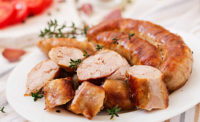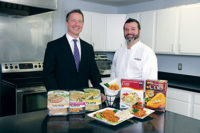High Liner Foods: maintaining a seafood savviness like no other
High Liner Foods revamps its supply chain network and expands its frozen seafood facility to stay ahead of consumer demands and sustainability mandates.




For many seafood processors, pumping out a host of seafood fare can be a bit rudimentary. Frozen seafood comes in; frozen seafood ships out. But, for companies like High Liner Foods, all it takes is a bit of seasonings, sauces and different shapes to transform an ordinary product into something extraordinary.
That’s why High Liner Foods received Refrigerated & Frozen Foods’ 2013 Frozen Foods Processor of the Year award. The Nova Scotia, Canada-based seafood processor is said to be the single largest importer in North American seafood, importing a few hundred million pounds of product. It ranked No. 18 in Refrigerated & Frozen Foods’ Top 150 Frozen Food Processors (March 2013 issue). And, the Portsmouth, N.H., and Newport News, Va., plants are undergoing some serious renovations.
Refrigerated & Frozen Foods toured the Portsmouth facility, which pumps out 60-70 million pounds of prepared, value-added frozen seafood annually for supermarkets, club stores, quick-service restaurants, K-12 schools, military, healthcare facilities, casual dining, national chains, businesses, catering, lodging and colleges/universities globally.
Producing more product in the same footprint
The 240,000-square-foot Portsmouth, N.H., facility was built in 1968, and has been renovated numerous times. For example, in 2009, the plant underwent a $7.3 million makeover, including state-of-the-art freezing and drying equipment, a fryer roasting process, an energy management system that’s designed to monitor/control equipment utilization and motion-sensored plant lighting systems.
“We’re updating the plant from the food safety and regulatory compliance standpoint to be top notch in food safety, but also from a manufacturing standpoint to be more efficient in our production changeovers,” says Art Christianson, senior vice president of U.S. plant operations. “We are continually rolling out new SKUs, so it is vital to better utilize the 24/7 time period that the plant is available. Plant capacity and automation projects are continually being implemented.”
Today, the Portsmouth plant is undergoing another expansion, which is expected to be complete by end of 2015. The 20,000-square-foot expansion includes an equipment washroom where equipment comes in to be cleaned without disrupting the operation of other lines. The expansion also includes rigid walk-on ceilings, air conditioning, a new drain system and an expanded maintenance shop for equipment rebuilds.
“Basically, it’s taking a 50-year-old plant and modernizing it to the next century of food safety,” says Keith Decker, president and COO of High Liner Foods’ U.S. division, which is headquartered in Portsmouth, N.H. “It takes a lot of activity to accommodate that while still manufacturing product at the same time.”
|
Company: High Liner Foods Plant Location: Portsmouth, N.H. Produces: 67 million pounds of prepared, value-added frozen seafood Total Square Feet: 240,000 Distribution: North America No. of Employees: 220 No. of Processing Lines: 4 No. of Packaging Lines: 8 Certifications: SQF, BRC |
From frozen to fresh to frozen
The Portsmouth plant is home to two 70,000- to 80,000-square-foot cold storage freezers set at -5°F with 10 frozen unloading docks. All product movement is controlled via an RF scanning process. The supply chain employs an ERP system that helps forecast and plan up to 12 months out. Raw material transports into the facility via rail or travels overland from a nearby port. All product comes in frozen, is then processed in a variety of value-added steps and then individually frozen through a spiral freezer.
Each of the four processing lines offer flexibility, and are capable of slicing, sawing, shaping and extruding. At the time of Refrigerated & Frozen Foods’ visit, High Liner Foods was processing frozen fish fillets in excess of 6,000 pounds an hour on one line.
In this process, the fish come in 16.5-pound frozen blocks that pass through a series of saws to be sliced into stick shapes. The sticks convey under a batter fall that coats the sticks with a pre-mixed refrigerated batter for flavor and adhesion. They then travel under a breading machine that coats the sticks with bread crumbs. This process can repeat for a series of applications. Operators will change the sequences depending on the product.
On a second line, natural fish undergo a similar process. Fish fillets are glazed with ice to prevent dehydration. They run under a 120°F hot water bath to remove the ice glaze.
The fillets are then seasoned with a series of batter and breading, enter a large fryer for 20-30 seconds to set the coating, which facilitates an oven bake recon, and travel into a spiral blast freezer at -35°F.
Then, the fillets convey into a vibratory rotary scale before exiting downward into one of the eight packaging lines.
Finished product is shipped off to a distribution center in Peabody, Mass., for final distribution to the customers. The plant runs six days a week, with two day shifts and a third shift for sanitation and maintenance. The quality team independently conducts about six or more mock recalls a year, and the facility undergoes numerous customer and regulatory audits.
High Liner Foods is at the forefront of quality and food safety. Quality is continually monitored on the lines where traceability and quality data is collected with data inputted into computer software for analysis and record keeping.
“As we move forward, we’re setting our sites up for a skill-based pay system, so as employees learn and demonstrate certain skills, they move into a different pay bracket,” Christianson says. “The employees operating certain equipment have to be at a very high skill level and very computer savvy. Positions are becoming more mental than physical these days.”
Supply chain goals for the future
Aside from it being a few extra steps on the retail side, domestically, High Liner Foods’ supply chain is organized the same. Yet, the $1.15 billion seafood processor continues to optimize its supply chain network from a global basis.
For example, one goal for 2014 is to achieve $25 million in cost savings initiatives that begin all the way back to where the fish is originally harvested.
“We’ve recently consolidated our ocean-going freight,” says Decker. “Historically, we would let our suppliers arrange for the container service from whatever country into the United States. What we have done is organized that so we control all the freights, we’ll pick it up domestically and we will put it on certain carriers with negotiating discount rates to bring into the United States.”
Additionally, High Liner Foods’ number of acquisitions prompted it to consolidate its import customs brokers into one broker with one set of documentation required.
The future also has High Liner Foods reducing or weaning down its processes, so it can utilize more product through the same manufacturing footprint.
“At this point right now, we have full facilities, so we have to create capacity inside of our existing footprint through more flexible work hours. We need lean perspectives to get more efficiencies out of the same infrastructure,” Decker says.
Another major focus for next year is reducing the company’s freight storage footprint.
“A lot of that comes down to how we’re loading out our trucks, so that we can use less LTL and more full truck loads leaving our facilities every day,” Decker adds. “How do you produce product that’s the same shape and same texture and deliver it 52 weeks of the year at the same price point across different species?” asks Decker. “The other challenge is the cost of raw materials. It changes every day. Shrimp has gone up $3 a pound just this year.”
Regardless of the obstacles, High Liner Foods maintains a seafood savviness that keeps it one step ahead of the rest.
Looking for a reprint of this article?
From high-res PDFs to custom plaques, order your copy today!










